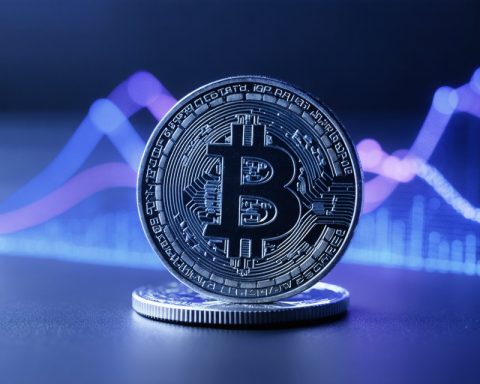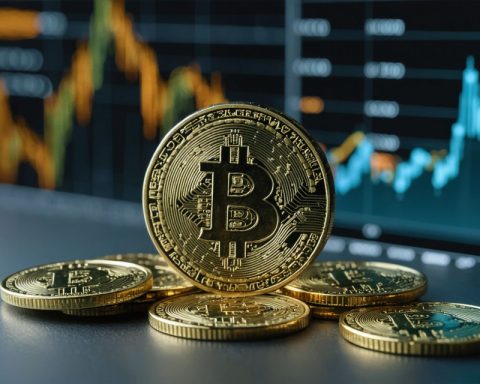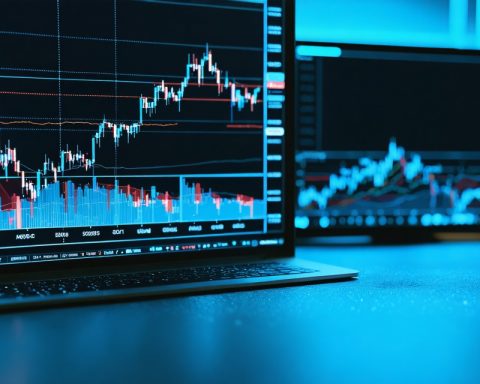- XRP’s value dropped by 8% following new U.S. tariff announcements, highlighting its vulnerability to global trade dynamics.
- XRP’s strength lies in its ability to facilitate low-cost international money transfers, bypassing traditional currency exchanges like SWIFT.
- The cryptocurrency’s future is uncertain due to potential declines in cross-border transactions influenced by heightened tariffs.
- Speculation around taxing U.S.-based blockchains in international trade could push traders towards alternative cryptocurrencies.
- Volatility might offer investment opportunities for those willing to take risks, leveraging potential future market recoveries.
- Despite current challenges, XRP’s core capabilities remain promising if global trade conditions improve.
XRP, once hailed as the beacon of modern financial transactions, finds itself at the heart of a global economic tempest. The Trump administration’s recent tariff announcements have sent ripples through markets, and while the final outcome remains uncertain, the immediate impact on XRP has been stark. The coin, pivotal for streamlined, low-cost international money transfers, saw its value dip by a formidable 8% as investors brace for potential market shifts.
XRP stands out in the digital currency world because of its ability to bypass the costly currency exchanges that burden traditional methods like SWIFT. As commerce increasingly breaches borders, currencies shift, and XRP finds its niche in facilitating these exchanges. Yet, its reliance on the pulse of global trade makes it vulnerable. A decline in cross-border transactions, partly spurred by stiffer tariffs, could diminish its allure as banks and financial entities reassess their inventory of XRP.
Tariffs, that quintessential economic lever, can ripple through markets like a stone cast in a pond. They inflate costs for consumers and disrupt supply chains, potentially stifling the demand for imported goods and, by extension, the currency needed to finance them. As America’s new trade policies loom, the specter of reduced demand for XRP hangs heavy, with banks potentially scaling back their holdings.
Furthermore, an intriguing new challenge emerges: the potential taxation of U.S.-based blockchains used in international trade. This fear, though speculative, could drive foreign traders to explore alternative cryptocurrencies, careful not to find themselves ensnared in unforeseen financial obligations.
Yet amidst this uncertainty, there remains a glint of opportunity for the intrepid investor. The present volatility could signal a chance to acquire XRP at a discount, betting on the prospect of a smoother economic horizon. It’s a gamble that requires resilience, patience, and a robust appetite for risk.
The road ahead for XRP is fraught with challenges, but it’s not insurmountable. A failure of policies to materialize, or their eventual inefficacy, might usher in a period of rejuvenation for the cryptocurrency. Indeed, XRP’s fundamental proposition remains intact, ready to capitalize should the trade winds shift favorably once more. For now, prudence may counsel awaiting calmer seas before embarking on this speculative journey.
XRP: Navigating the Economic Storm and Embracing Future Opportunities
Understanding XRP’s Role in Global Finance
XRP, a digital currency created by Ripple Labs, plays a pivotal role in facilitating fast and low-cost cross-border transactions. Unlike traditional methods such as SWIFT, XRP’s blockchain technology enables financial institutions to bypass expensive currency exchanges. However, its close ties to global trade flow make it susceptible to economic policies designed to alter these exchanges.
Key Features of XRP
– Transaction Speed: XRP transactions are completed in seconds, compared to minutes or even days for traditional banking systems.
– Low Fees: Transferring money with XRP typically incurs minimal fees, making it attractive for large-scale international transfers.
– Decentralization: While Ripple Labs maintains significant control over XRP, it still operates on a decentralized network enhancing security and transparency.
– Scalability: XRP has the capacity to handle up to 1,500 transactions per second, making it one of the most scalable cryptocurrencies available.
Potential Market Dynamics
How-To Navigate Current Volatility
1. Assess Risk Tolerance: Investors should consider their risk appetite before delving into XRP or any cryptocurrency. Given the current economic volatility, the stakes are particularly high.
2. Monitor Economic Policies: Keeping an eye on trade policies, especially those involving tariffs, can provide insights into potential market movements.
3. Diversify Holdings: Diversifying your portfolio by including other assets can mitigate risks associated with XRP’s volatility.
Real-World Use Cases
– Banking Sector: Banks utilize XRP to enhance liquidity when processing international transactions.
– Remittance Industry: Companies working in the remittance space leverage XRP to offer efficient and cost-effective services to customers.
Market Forecasts & Industry Trends
– Short-Term: The current uncertainty around global trade policies might deter large financial institutions from expanding their XRP holdings.
– Long-Term: As individual regions explore blockchain solutions, XRP could regain momentum if supportive economic conditions return.
Reviews & Comparisons
– Competitors: Cryptocurrencies like Stellar (XLM), also focusing on low-cost transactions, pose competition to XRP.
– Advantages: XRP’s direct partnerships with financial institutions give it an edge over many other digital currencies.
Addressing Potential Concerns
Controversies & Limitations
– Regulatory Scrutiny: Ripple’s ongoing legal battle with the SEC adds uncertainty to XRP’s future.
– Decentralization Concerns: Some critics argue Ripple Labs’ control over the majority of XRP tokens contradicts the ethos of blockchain decentralization.
Security & Sustainability
– Security Measures: As XRP transactions are completed quickly, they are less exposed to common security threats compared to slower systems.
– Environmental Impact: XRP’s consensus mechanism (a type of validating transaction) is generally more energy efficient than Proof of Work systems like Bitcoin’s.
Insights & Predictions
– Global Policy Developments: Looser trade restrictions and an enhanced interest in blockchain technology could revitalize XRP’s position.
– Central Bank Digital Currencies (CBDCs): As more countries investigate CBDCs, there might be new integration opportunities for XRP within this scope.
Pros & Cons Overview
– Pros:
– High transaction speed
– Low transaction costs
– Established partnerships with banks
– Cons:
– High centralization level
– Vulnerability to regulatory changes
Actionable Recommendations
– Patience is Key: Given the current economic uncertainties, it might be wise for investors to wait for clearer signals before investing heavily in XRP.
– Stay Informed: Regularly following trade policy changes and Ripple’s legal developments can help anticipate XRP’s future market behavior.
Suggested Resources
For more information on cryptocurrencies and financial technologies, you may visit the Ripple website.
By understanding these dynamics, investors can make more informed decisions and remain agile in an ever-evolving market.










